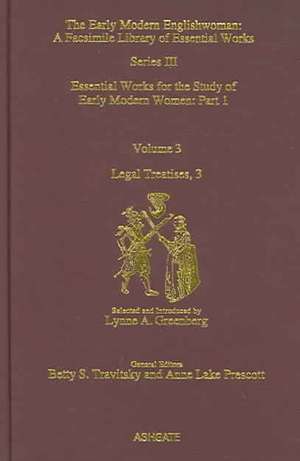Legal Treatises: Essential Works for the Study of Early Modern Women: Series III, Part One, Volume 3: The Early Modern Englishwoman: A Facsimile Library of Essential Works for the Study of Early Modern Women Series III, Part One
Autor Lynne A. Greenbergen Limba Engleză Hardback – 24 oct 2005
| Toate formatele și edițiile | Preț | Express |
|---|---|---|
| Hardback (3) | 247.20 lei 6-8 săpt. | |
| Taylor & Francis – 24 oct 2005 | 247.20 lei 6-8 săpt. | |
| Taylor & Francis – 24 oct 2005 | 506.07 lei 6-8 săpt. | |
| Taylor & Francis – 24 oct 2005 | 835.13 lei 6-8 săpt. |
Preț: 835.13 lei
Preț vechi: 1111.73 lei
-25% Nou
Puncte Express: 1253
Preț estimativ în valută:
159.82€ • 166.24$ • 131.94£
159.82€ • 166.24$ • 131.94£
Carte tipărită la comandă
Livrare economică 14-28 aprilie
Preluare comenzi: 021 569.72.76
Specificații
ISBN-13: 9780754631132
ISBN-10: 0754631133
Pagini: 616
Dimensiuni: 138 x 216 x 44 mm
Greutate: 1.3 kg
Ediția:1
Editura: Taylor & Francis
Colecția Routledge
Seria The Early Modern Englishwoman: A Facsimile Library of Essential Works for the Study of Early Modern Women Series III, Part One
Locul publicării:Oxford, United Kingdom
ISBN-10: 0754631133
Pagini: 616
Dimensiuni: 138 x 216 x 44 mm
Greutate: 1.3 kg
Ediția:1
Editura: Taylor & Francis
Colecția Routledge
Seria The Early Modern Englishwoman: A Facsimile Library of Essential Works for the Study of Early Modern Women Series III, Part One
Locul publicării:Oxford, United Kingdom
Cuprins
Volume 3, Preface by the General Editors, Introductory Note, Baron and Feme: A Treatise of Law and Equity, Concerning Husbands and Wives (3rd ed., 1738)
Descriere
This first volume of "Legal Treatises" reproduces The Lawes Resolutions of Womens Rights (1632), the first known treatise devoted to the legal rights of women. "The Womans Lawyer," as the treatise's running headline and spine title read, was published anonymously in 1632; the title page fails to identify the original author of the work, and its authorship remains in question today. At 404 pages, the text represents a massive effort of consolidation, organizing the disparate and hitherto uncompiled aspects of the common law applicable to women into a logical framework. It is unusual among early modern legal treatises in its stated goal of providing a "popular kind of instruction" to its readers.





